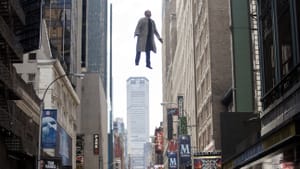Stay in the Loop
BSR publishes on a weekly schedule, with an email newsletter every Wednesday and Thursday morning. There’s no paywall, and subscribing is always free.
The paradox of art
Iñárritu’s ‘Birdman’

Birdman is a cinematic coup by up-and-coming writer/director Alejandro González Iñárritu, who takes a basic plot and transforms it to mirror the inner craziness of the main character, asking questions about the human persona, film, theater, and the dynamics of our time.
Riggan Thomson (Michael Keaton) attained now forgone success playing a superhero, Birdman, just as Keaton himself played Batman. Now, as old age approaches, he wants to prove that himself by producing, directing, and starring in a serious Broadway play. In the final rehearsal stages, the production seems to languish, so Riggan brings in Mike Shiner (Edward Norton), a popular, egotistical actor who, if nothing else, will attract an audience. It turns out, though, that Mike’s brilliant insights both stimulate Riggan and trigger endless doubts about his own adequacy and viability. The film shows an insecure Riggan struggling to hold onto any vestige of self-worth and willing to go to any lengths to preserve it.
Reality, fantasy, art
The film addresses two existential questions: Is there any difference between reality, fantasy, and art? And — in a time when torrents of Twitter and Facebook streaming signify nothing — what, if anything, is left of the embodied, foibled but adventurous human soul that seeks integrity through its own being as opposed to, say, going viral or getting glowing reviews?
Birdman — both Keaton’s character and the film itself — intentionally confounds reality, fantasy, and theater into an explosive mix. The movie begins with Riggan in his dressing room meditating — and levitating. We wonder if he’s attained samadhi, but we soon find that he can move and destroy objects without touching them and fly over the streets of Manhattan like — you guessed it — Birdman, who has become his alter ego. Reality and fantasy have become one and the same for Riggan, just as it may be for all of us.
We could interpret Riggan as delusional, or merely living out a Walter Mitty fantasy, but Iñárritu plays with our sense of reality. A film can portray any “reality” it wishes, so he makes Riggan’s excursions into hyper-reality believable, or at least conceivable. This state is sustained by a hypomania that pervades both Riggan’s alcohol-infused psyche as well as a variety of special effects, rapid scene sequencing, and a remarkable camera operator who follows Riggan as if riding on his back. This is a film where illusion is sustained through motion, dissolving the difference between reality and fantasy as in a kaleidoscopic dream.
Extreme Stanislavski
The film then brings in the level of theater and the arts by confabulating cinema, live theater, and real life. Riggan’s play-within-a-film is based on Raymond Carver’s book What We Talk About When We Talk About Love. Carver wrote bluntly about the cruelty and ignorance that pervades human relationships, and as the show’s rehearsals proceed, the actors and their respective characters begin to fuse in an extreme version of the Stanislavski method, where the actors become immersed in the emotional states of their parts.
When Riggan and Mike lock horns with each other, their contentiousness immediately informs their characters, and while this gives the play a certain excitement, it drives Riggan into a crisis of self-confidence. The real Riggan merges with his fantasy Birdman personality, which in turn penetrates his role in the play. Director Iñárritu is questioning whether there is any difference between life (the film) and art (the play) and increasingly supplies the answer that if anything, the differences are obscure, thus justifying the position of the film itself.
A commentary on the current cyber-scene
The film distinguishes itself from the massive number of romantic novels and film noir detritus about artistic integrity and commitment to life by probing the implications of high-tech special effects and cyberspace for contemporary life on the planet. For example, Sam Thomson (Emma Stone), Riggan’s millennial daughter, is a Facebook and Twitter enthusiast. In a riotous scenario, Riggan finds himself accidentally locked out of his dressing room in his underwear. Panicked, he dashes aimlessly through the theater’s hallways, only to find himself exiting the theater’s stage door on Broadway streaking half-naked through the crowd. The passersby love the action and post their videos on Facebook, which then go viral, catapulting Riggan to the resurrected fame he craves. Daughter Sam is thrilled and praises her father for his apparent ingenuity.
In this eventuality, we suddenly come face-to-face with the fact that advanced computer technology — without which the film could never have been made — has erased whatever might be left of the coherent empowered individual self and his or her strivings for personal and artistic integrity. If all that we are as human beings can be constructed and deconstructed in megabytes, and recognition depends on momentary excitement and sensationalism, what is left of the embodied yet soulful human identity that took nature millions of years of evolution to create? Riggan himself, despite his devotion, seems unable to define and sustain himself as a creative force in the universe. The film repeatedly asks whether such a possibility still exists in today’s world.
A cinematic koan
In such a cyber-dominated world, Birdman itself manifests as a paradox: It places itself above the crowd as a noble, life-sustaining critique of the senselessness of contemporary life. Yet by relentlessly pointing to such futility, it deconstructs itself and acknowledges its own lack of meaning. Whether such an unresolvable paradox constitutes an art form or rubbish cannot be decided by comparisons to Godard, whose early seminal work preceded the cyber-frantic New Millennium. Only the film’s legacy can decide its virtue. We shall have to see what Iñárritu himself — as well as other filmmakers — generate in the future based upon similar premises and approaches. Birdman could lead to a new genre of film, or it could turn out in retrospect to have simply been an interesting cyber-phenomenon, like those viral videos of people doing crazy things on the street.
To read Judy Weightman's review of Birdman, click here.
What, When, Where
Birdman, or the Unexpected Virtue of Ignorance. Alejandro González Iñárritu directed; written by Alexander Dinelaris, Nicolás Giacobone, Alejandro González Iñárritu, and Armando Bo; cinematography by Emmanuel Lubezki; music composed by Antonio Sanchez. Philadelphia area showtimes.
Sign up for our newsletter
All of the week's new articles, all in one place. Sign up for the free weekly BSR newsletters, and don't miss a conversation.
 Victor L. Schermer
Victor L. Schermer